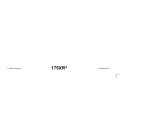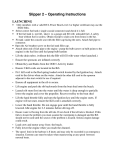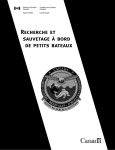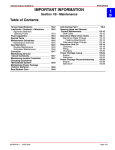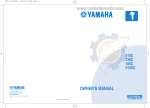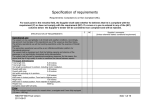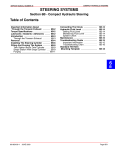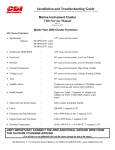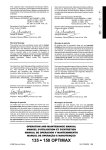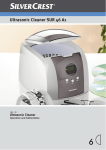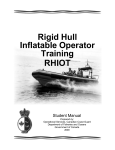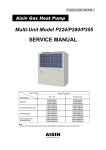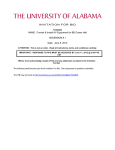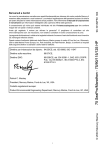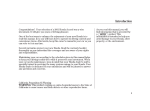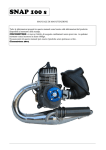Download Preventative Maintenance for Rigid Hull Inflatables 2.3.2 Fuel
Transcript
Preventative Maintenance for Rigid Hull Inflatables 2.3.2 Fuel System 2.3.2.1 Overview The facing page shows the fuel systems of the 733, 630 OB and 590 OB vessels. For other fuel system configurations, please consult your Hurricane Technical Manual. 2.3.2.2 Inspection Requirements Follow these general tips to keep your fuel system working well. ¾ Always keep fuel storage tank full. Fuel level is shown on the console-mounted fuel gauge. Note that electric fuel gauges are prone to inaccurate readings. Determine fuel consumption through trials and by monitoring operating time to accurately determine fuel reserve capacity. ¾ Use the correct fuel (gasoline). With gasoline, make sure to use the correct octane and gasoline/oil mixture when refueling (check the engine manufacturer’s technical manual for the right mix). ¾ If your vessel has two fuel tanks, always use the aft tank first. This maintains your vessel’s optimum center of gravity. SAFETY: A gasoline fire or explosion can cause serious injury or death. Carefully follow all service instructions. Always stop the engine and disconnect the battery. DO NOT smoke or allow open flames or sparks in the area. Isolate the batteries and pull the kill switches. Turn off bilge switch. 69 Preventative Maintenance for Rigid Hull Inflatables Gas begins to deteriorate after 5 weeks. Checking for water in shipboard or shorebased fuel storage containers cannot be stressed enough. A gas drum has a 3-month life span or less in shipboard environments due to rust and condensation. The fuel octane rating also has a 3-month life span without any gas stabilizer added to it. It is imperative to rotate fuel and gas drums as a part of your preventative maintenance program. Preventative measures at the source will help cut down on later fuel problems. Fuel Line Visually inspect the fuel line for cracks, swelling, leaks, hardness, or other signs of deterioration or damage. If any of these conditions is found, it must be replaced. Never use gas line antifreeze in any outboard engine. Use Quicksilver Fuel Treatment and Stabilizer (#92-12253). SAFETY: Fuel Oil System Compartment Do not use electric ¾ Open Fuel tank void space. pumps. They can ¾ Inspect top of fuel tank for fuel produce sparks that can and clean up any moisture you ignite gas fumes. see. ¾ Check void space bilge for fuel or water. If only water present, pump out bilge using a hand pump and wipe dry. If fuel oil is present, pump the bilge water into a waste barrel using a hand pump. Wipe dry. Fuel Oil Tank ¾ Inspect tank for cracks, leaks, damage or bulging of sides. ¾ Notify the Mate/Coxswain if you find problems. 70 Preventative Maintenance for Rigid Hull Inflatables Hoses ¾ Inspect all fuel oil hoses for signs of chafing, cracking, nicks, sharp bends, leaks and/or holes. If you find any damage, replace or repair the hose. ¾ Inspect hose path for any areas where chafing (rubbing) may occur. If you find such an area, protect the hose by re-routing it, or by putting a protective wrapping over the area. ¾ Feel the hose for firmness. If a hose feels mushy, replace it as soon as possible. Hose Clamps and Fittings Do not over tighten fittings as they are being threaded into plastic. ¾ Visually inspect all hose clamps and fittings to ensure they are in good condition. ¾ Check all hose clamps for tightness. ¾ Inspect areas around fittings for signs of leakage. If leakage found, remove hose and undo the fitting. Re-install the fitting using new thread sealant. Racor Filters ¾ Visually inspect filter bowls and drain as required. ¾ Check filter bowls for cracks and/or leaks. Repair as required. ¾ Inspect inlet and outlet fittings for tightness. Adjust as required. Priming Bulbs ¾ Inspect for visible signs of cracking and/or leaks. ¾ Test bulbs by pumping, ensuring that they become and stay firm. ¾ Inspect inlet and outlet fittings for tightness and condition. Fuel Oil Gauge ¾ Inspect sending unit cover for tightness. ¾ Visually assess the level of the fuel oil tank and compare it to the reading provided by the gauge. If the gauge is not working, check that it has power supply (batteries on, breaker panel in good condition). ¾ If the gauge still doesn’t work, check that the wire isn’t broken. ¾ If wiring is in good condition and the power supply is working, the problem may be in the sending unit. If this is the case, notify the Mate/Coxswain before proceeding any further. Engine Connection ¾ Inspect fitting for tightness and condition. ¾ Inspect engine fuel system for leaks and repair as required. 71 Preventative Maintenance for Rigid Hull Inflatables Fuel Water Separator ¾ Visually inspect both Racor filters on the outboard’s fuel vapor separator for water and/ or sediment on a daily basis. Remote Tank ¾ Check all connections and NOTE: If Racor filters are full of water, the outboard water separators should also be drained. If you find a lot of water, drain other components as well (e.g. fuel pump and fuel rail on a DFI engine). See outboard service manual for details. clamps for tightness. ¾ Inspect all cap seals for good condition. Replace if not in good condition. ¾ Inspect remote hose for good condition. Ensure that there are no chafing marks. ¾ Check that the tank is well secured. Remote Oil Reservoir Tank ¾ While the engine is running, inspect engine reservoir, hoses, fittings and cap for leaks. ¾ If you find leaks, repair them and wipe up any spillage. 2.3.2.3 Preventative Maintenance Requirements Before servicing any part of the fuel system, stop the engine and disconnect the battery. Drain the fuel system completely. Use an approved container to collect and store fuel. Wipe up any spillage immediately. Material used to contain spillage must be disposed of in an approved receptacle. Any fuel system service must be performed in a well-ventilated area. Inspect any completed service work for sign of fuel leakage. SAFETY: A gasoline fire or explosion can cause serious injury or death. Carefully follow all service instructions. Always stop the engine and disconnect the battery. DO NOT smoke or allow open flames or sparks in the area. Isolate the batteries and pull the kill switches. 72 Preventative Maintenance for Rigid Hull Inflatables Filters vary in construction. Consult the manufacturer’s technical manual for instructions on fuel filter element replacement. Use the following general procedure: 1. Unscrew the old element from the filter bracket. 2. Coat the sealing ring on the new fuel filter element with engine oil. Thread new filter element onto the bracket, tightening securely by hand. 3. Run engine and check for leaks. Fuel Filters ¾ Drain the transom-mounted fuel water separator filter daily. ¾ Drain the water separator filter located on the engine on a weekly basis. When filter maintenance is done regularly, the engine’s filter should show little or no water, because the transom filter will have captured it first. ¾ Replace the filter cartridge every 100 hours. Do not rely on a visual water fuel separation line being obvious on inspection. There may be mostly water in the inspection bowl, fooling you into believing that it’s fuel. ¾ Drain the bowl into a can and note whether there is water present. ¾ Drain the filter until there is only fuel being discharged. Change the filter element annually, or as required, depending on local fuel quality. The newer model fuel-injected engines require the use of fuel conditioners and decarbonizing agents. ¾ Add the fuel conditioner to the fuel after re-fuelling, ensuring that the correct amount is added for the amount of fuel taken. ¾ Spray the de-carbonizing agent into the air box at a Fuel conditioner extends the shelf given r.p.m. once the life of the fuel, and reduces the engine has been warmed amount of carbon build-up in the up. cylinders. ¾ Read the instructions on the de-carbonizing agent, The de-carbonizing agent as each manufacturer removes most of the carbon requires a different method build up. of product application. 73 Preventative Maintenance for Rigid Hull Inflatables Fuel Water Separator Draining ¾ In summer, drain plastic bowls as required. In winter, drain daily. Safely dispose of rags and drained liquid. ¾ To drain, place save-all pan under Racor plastic bowl. Plug both compartment drains to contain accidental fuel spillage. ¾ Loosen self-venting drain and remove water. ¾ Once bowl is drained, close self-venting drain. ¾ Wipe up any spillage. Changing the Fuel Water Separator Filter Removing the Old Filter ¾ Place save-all pan under filter being changed. ¾ Plug compartment drain holes. ¾ Loosen self-venting drain and drain filter unit. ¾ Remove Racor filter and plastic bowl as one assembly. ¾ Remove reusable plastic bowl from filter assembly. ¾ Remove O-ring from plastic bowl gland. ¾ Clean bowl and inspect for damage. ¾ If bowl in good condition, clean O-ring gland. Racor Filter Legend: Racor Filter 1 2 3 4 5 1 = Mounting Head 2 = Filter Top Seal 3 = Filter Element 4 = O-Ring 5 = Reusable Plastic Bowl 6 = Self-Venting Drain 6 74 Preventative Maintenance for Rigid Hull Inflatables Installing a New Filter ¾ Lubrciate new O-ring with motor oil or light grease, and place in plastic bowl ¾ ¾ ¾ ¾ ¾ ¾ ¾ ¾ gland. Close self-venting drain plug. SAFETY: Spin plastic bowl onto new Racor Improper installation filter and tighten by hand. Do not may cause explosion use tools to tighten plastic bowl or fire, resulting in or filter element. Fill filter bowl assembly with clean serious injury or fuel oil. death. Lubrciate top of Racor filter using motor oil or light grease. Carefully spin unit only mounting head. After the filter seal makes complete contact with the mounting head, tighten the unit an additional 1/3 to 1/2 turn by hand. Complete priming fuel system and check for leaks. Wipe up any spillage and safely dispose of filter, rags and liquid. 1 Remote Tank Topping Up ¾ Place rags around the filling area to catch any ¾ ¾ ¾ ¾ spilled or dripped oil. Remove oil-filling cap from each reservoir and add oil to the required level. Use only Optimax (1 gal. 92-877694K-1; 2.5 gal. 92-881108K-1; or 45 gal. 92-881109K1). Reinstall cap and tighten securely. Clean up any spilled oil and dispose of waste material as required. Always double check that remote oil tank caps are installed tightly, as any air leak will prevent oil moving up to the engine reservoir tank causing severe engine damage. Oil can also be forced into the bilge if remote tank lids are not secure. 75 2 3 3 1 1 Remote Tank Legend: 1 = Caps 2 = Hose 3 = Clamps Preventative Maintenance for Rigid Hull Inflatables Engine Reservoir Tank Topping Up ¾ Remove cover of each engine. ¾ Visually check oil level in reservoir. ¾ Add oil as required (use the same oil as in Cap the remote reservoir). Topping can be done by just cracking cap loose as engine is running, allowing air to escape as oil is pumped in by engine system. ¾ Tighten fill cap. ¾ Note: New engines might not have a full tank, as they are shipped from the factory half full. The oil alarm will sound when the engine is started for the first time. SAFETY: Always double check that the engine oil tank cap is installed tightly, as any leak will cause oil spillage. Oil spillage may cause an engine fire. SAFETY: Always clean up any fuel spills immediately. Dispose of liquid and rags safely. Wait until fumes dissipate before starting the engine. 76 Preventative Maintenance for Rigid Hull Inflatables 2.3.3 Gauges and Wiring 2.3.3.1 Inspection Requirements Inspect all gauges and wiring for broken wires, loose connections and/or faulty gauges every day. 2.3.3.2 Preventative Maintenance Requirements Gauges ¾ It is common for some 733s to have a bit of moisture in their gauges. The moisture usually goes away once they get warm. ¾ A few inaccurate tachometers have been noticed in the fleet. The maximum r.p.m. for an EFI 150 is 5600 and 5750 for DFI Optimax engine. ¾ To check the accuracy of your tachometer, you will need the Digital Diagnostic Terminal (DDT) hooked up to your engine. Compare the true r.p.m. from the DDT with what your tachometer gauge indicates at various r.p.m. ranges. ¾ If there is a discrepancy, go with the DDT as the true r.p.m. reading. ¾ Check the true r.p.m. against the recommended r.p.m. for your propeller. If necessary, change the propeller to one with a lower pitch. 77 Preventative Maintenance for Rigid Hull Inflatables Wiring Salt water is wiring’s worst enemy. The most common problems include corrosion on terminals, loose connections, rotten wires (i.e. burnt, green, and/or abandoned wires that weren’t taken out properly the first time). ¾ Inspect all wiring components thoroughly. When in doubt, change the ¾ ¾ ¾ ¾ component to ensure that all contacts are free of corrosion. Make sure that: 1. All contacts are tight and have proper nuts (brass, not steel). 2. There is no excessive moisture in the contacts. 3. Proper gauge of wire is used for the right application, to reduce the possibility of chafing. 4. All breaks have waterproof boots on them and the proper Amp rating for the application. Use Ship to Shore and dielectric grease or Merc corrosion guard (92-827933 55) on all exposed wiring and electrical components. Keep all wires neatly tie wrapped together. Become familiar with the electrical system and know all the related components and their functions. Knowing the system will help you trouble-shoot future problems. If you do these basic procedures on a regular basis, there is less chance of something failing. It will also help you find a problem and fix it before it becomes something major (short circuit = chance of a fire). SAFETY: It is known that some people have replaced breakers with a larger amp rating than required. This could cause a short and a fire. Contact the Officer-in-Charge of Inflatable Craft Maintenance before replacing a breaker with one of a larger amp rating. 78 Preventative Maintenance for Rigid Hull Inflatables 2.3.4 Corrosion Control Anodes 2.3.4.1 Overview Anodes help to protect your engine against corrosion. They allow their metal to be slowly eroded instead of the metal of the outboard itself. Each outboard has three corrosion anodes, located as follows: ¾ Two at the sides, just above the trim tab (a and b) (one on OMC engines). ¾ One at the bottom of the transom bracket (c). Hulls also have anodes located on the transom. 2.3.4.2 Inspection Requirements ¾ Inspect the anodes for erosion and replace if less than 3/4 (75%) of original size. ¾ If you replace the trim tab anode, be sure to install the new unit in the exact same position. ¾ Check that all anodes are securely fastened. ¾ Ensure that none of the anodes are painted or covered with a protective coating. If an anode is coated over, remove the paint or coating immediately. MERC Outboard a 2.3.4.3 Preventative Maintenance Requirements c ¾ Replace anodes at 50%. ¾ Never paint over anodes. ¾ Clean area before replacing zincs and anodes. OMC Outboard 79 Preventative Maintenance for Rigid Hull Inflatables 2.3.5 Propeller 2.3.5.1 Overview WARNING: Propellers don’t require much care, but you do need to check them daily to maintain vessel performance. Never repair propellers in the field, as you can cause more damage. 2.3.5.2 Inspection Requirements ¾ ¾ ¾ ¾ Visually inspect the propellers for damage. If the damaged area is larger than a dime, replace the propeller. Inspect the propeller shaft to ensure that it is straight. If using flow-torque hubs, re-torque the hubs after a good run (55 ft. lbs. of torque). 1 1. 2 This propeller has thrown a blade because a very small nick has not been repaired and it has gradually cracked and blown off. 2. Note: This propeller has hit a very hard object and may be out of balance even after extensive repairs. It should be replaced. Cavitation is damage caused by air bubbles as the propellers race through the water. 80 Preventative Maintenance for Rigid Hull Inflatables 2.3.6 Outboard Motor Controls 2.3.6.1 Inspection Requirements Controls ¾ ¾ ¾ ¾ Check 2 control base securing screws for tightness—see diagram below (a). Check 2 control handle mounting brackets—see diagram below (b) . Check 2 nylon locknuts—see diagram below (c). Ensure all electrical connections are tight and the harness is properly secured and out of the bilge. ¾ Check controls for ease of operation. If controls require increase in effort to move, investigate the cause. Do not force controls (check control and engine end for binding). ¾ Repair and lubricate the unit using Quicksilver 2-4-C Marine Lubricant. a. Screw (10-32X4.00 (2) b. Mounting Bracket (2) c. Nylon Locking Nut 10-32 (2) 81 Preventative Maintenance for Rigid Hull Inflatables Steering System Oil ¾ Remove helm pump filler plug. ¾ Helm units are mounted at 20 degrees. The oil level should be ½” (12.7 mm) from the hole. ¾ If oil level is below required level, top up. Use same oil as presently in the system. See box for recommended oils. Recommended Steering System Oils 1. 2. 3. 4. 5. Texaco H015 Shell Aero 4 Esso Univis N15 Chevron Aviation Fluid A Fluids Meeting Mil H5606c Specifications 6. Teleflex Steering Fluid 7. Power Steering Fluid 8. Sea Star Fluid #HA5430 WARNING: Never use brake fluid. It may cause irreparable damage and loss of steering. Steering Gear Fasteners On a weekly basis: ¾ ¾ ¾ ¾ ¾ ¾ Physically inspect all steering gear fasteners and linkages for tightness. Tighten all loose fasteners and replace any damaged or missing parts. Wiggle all ball joints to check for excessive wear. Replace as required. Inspect 4 nuts securing the help pump. Check for tightness. Inspect helm-securing nut for tightness. Inspect all hydraulic lines and fittings for tightness. Steering System Fasteners 82 Preventative Maintenance for Rigid Hull Inflatables Tie Bar System Check for overall condition of steering system and components. Tie Bar System 1 SAFETY: The threaded rod must always fully cover Inspection Hole 1, but NEVER Inspection Hole 2 (see right). Failing to observe this warning may result in one engine being separated from the steering system, resulting in property damage and/or personal injury. 2 Steering Gear Cylinder Shafts A) Visually inspect the cylinder shafts for damage. ¾ Look for large nicks, scouring, flaking of metal, gouges, loose connections or bends in the unit. ¾ Inspect shaft for salt water corrosion. A rough or damaged shaft will cause seal damage and oil loss. Tell the Mate/ Coxswain about damage. 83 Cylinder Shaft Damage Nicks Gouges Flaking Preventative Maintenance for Rigid Hull Inflatables B) Visually inspect the seals ¾ Inspect seals in place for damage (small tears, pieces missing). ¾ Inspect the seal area for oil leakage. ¾ Have one person turn the helm to port. Apply enough force to exceed relief valve pressure. Maintain pressure. ¾ Second person should fully inspect extended cylinder shaft. If minor damage is found, polish area using Brasso. Clean polished area thoroughly with solvent after completion. Wipe with steering fluid. ¾ At the same time, the second person should inspect the shaft for leaks and/ or damage. ¾ Tell the Mate/Coxswain if a seal is leaking. Replace the seal or unit as soon as possible. ¾ Check oil reservoir for correct fluid level. Add as required. If a seal is replaced or reservoir empty (low), bleed the steering system. Wipe up any oil around the steering cylinder upon completion. Leak in Way of Seal Leak in Way of Seal Then repeat the procedure again, with the helm turned to starboard. WARNING: Using a steering system with leaking seals or badly damaged shafts may result in the complete loss of oil. This can cause steering failure resulting in property damage and/or personal injury. 84 Preventative Maintenance for Rigid Hull Inflatables Steering Gear Tilt Tube ¾ Inspect outboard motor tilt tube for salt deposits and/or corrosion (see illustration for areas vulnerable to corrosion). Clean as required. ¾ Grease through nipples as required (see illustration for grease points). ¾ If salt deposits or corrosion is extreme, unbolt steering system arms and clean tube and carrier. Reassemble steering system as outlined in the product manual. Steering Gear Tilt Tube Check here for corrosion Check here for corrosion 85 Grease through nipples as required. Preventative Maintenance for Rigid Hull Inflatables 2.3.6.2 Preventative Maintenance Requirements Check Shift Cable Adjustments Shift Cable Retainer Cable Barrel Cable End Guide A) Remove Propeller 1. With remote control in Forward. 2. The propshaft should lock solidly in gear. 3. If the propshaft does not lock, adjust cable barrel closer to cable end guide. B) Increase Gap 1. 2. 3. 4. Shift remote control into Neutral. The propeller shaft should turn freely in either direction without any drag. If any drag is present, adjust cable barrel away from cable end guide. Repeat Steps A and B. Pull emergency Kill Switches. Remove ignition keys. Ensure propeller area clear of personnel. 86 Preventative Maintenance for Rigid Hull Inflatables C) Decrease Gap 1. Shift remote control into Reverse (turn shaft while checking propeller shaft for movement). 2. The propshaft should lock solidly in gear. 3. If shaft does not lock, adjust barrel away from cable end guide. 4. Repeat steps A through C. D) Increase Gap 1. 2. 3. 4. Shift remote control into Neutral. The propeller shaft should turn freely in either direction without any drag. If any drag is present, adjust the barrel closer to cable end guide. Repeat steps A through D. Pull emergency Kill Switches. Remove ignition keys. Ensure propeller area clear of personnel. 87 Preventative Maintenance for Rigid Hull Inflatables A C D B Throttle Cable Adjustment Step A (Set-up) Carry out this procedure before starting the engines. 1. 2. 3. 4. 5. 6. 7. 8. Pull emergency Kill Switches. Remove ignition keys. Ensure propeller area clear of personnel. Secure RHI properly in its cradle. Install water muff. Block off area around propeller. Remove throttle cable from lever anchor pin (B). Remove cable retainers (D). Remove throttle cable barrel from receptacle. Turn on water supply. Check to make sure the propeller area is clear of people or foreign objects. 88 Preventative Maintenance for Rigid Hull Inflatables Step B (Testing) 1. Start engine being tested. Ensure good water discharge. 2. Warm up engine. 3. Adjust engine RPM to 600-700 RPM in forward gear. Never increase RPM above 750, or you will damage the engine. 4. Shift control lever into Neutral. 5. Reattach cable end to throttle lever anchor pin and secure with latch (B). 6. With the throttle cable attached to the throttle lever, hold throttle lever against idle stop (C). 7. Adjust throttle cable barrel. It should slip into the barrel receptacle (A) with a very light pre-load of throttle lever against the idle stop (C). A piece of paper should drag through, but not tear. 8. Lock barrel back into place using cable retainer. Block off area around propellers. Visually inspect area around propellers for foreign objects. Have one crew member stand by to ensure nothing goes near the propellers. Step C (Pre-Load Check) 1. Place a thin piece of paper (C) between the idle stop screws and idle stop. 2. If the pre-load is correct, the paper can be removed without tearing, only feeling a slight drag. 3. If the paper tears, or if there’s drag present, readjust the barrel. Do not try to synchronize control head shift handles by adjusting the throttle and shift cables, or any screws at the engine. Too much pre-load creates an unnecessary strain on the control cable. Throttle adjustments must be re-checked once the vessel is afloat. Readjust as necessary. 89 Preventative Maintenance for Rigid Hull Inflatables Controls Repair and lubricate the unit using Quicksilver 2-4-C Marine Lubricant. Lubricating Points on Control Cable Remote Control This illustration depicts an OMC-type control cable. Adjusting Barrel or Knurl Engine End SAFETY: If you don’t tighten set screws, handles may disengage, causing a loss of throttle shift control. To prevent shorts, make sure that all connections are secure and have been lubricated with dielectric grease. 90 Preventative Maintenance for Rigid Hull Inflatables Steering System Bleeding This operation requires two people. One at the helm and one at the cylinder. Step 1 ¾ Remove steering reservoir cap. ¾ Install threaded end of filler tube into reservoir filler hole (helm). ¾ Remove lid from oil bottle. Use only recommended ¾ ¾ ¾ ¾ oils—see below. Holding bottle upright, screw it into the filler tube bottle cap. Turn bottle upside down and punch a small hole into the bottom of bottle. Fill reservoir full of oil (make sure oil is always visible in the filler tube). If the level falls off, stop immediately and install a new oil bottle. WARNING: If the oil level gets too low, more air will be sucked into the system and you must start the bleeding process again. Recommended Steering System Oils 1. 2. 3. 4. 5. Texaco H015 Shell Aero 4 Esso Univis N15 Chevron Aviation Fluid A Fluids Meeting Mil H5606c Specifications 6. Teleflex Steering Fluid or 7. Power Steering Fluid 8. Sea Star Fluid #HA5430 91 Preventative Maintenance for Rigid Hull Inflatables Step 2 ¾ Turn helm to starboard until the cylinder rod is fully extended on the right side of the cylinder. ¾ Open the right hand bleeder. Step 3 ¾ Hold onto the cylinder rod with your hand, preventing it from moving back into the cylinder. ¾ Turn the helm to port until a steady stream of air-free oil comes out of the bleeder. This may require ½ bottle or more of oil. ¾ While still turning the helm to port, close the right hand bleeder screw. ¾ Release the cylinder rod. Step 4 ¾ Top up or replace oil bottle. ¾ Continue turning the helm to port until the cylinder rod is fully extended on the left side of the cylinder. ¾ Open the left hand bleeder screw. Step 5 ¾ Hold onto the cylinder rod with your hand, preventing it from moving back into the cylinder. ¾ Turn the helm to starboard until a steady stream of airfree oil comes out of the bleeder. This may require ½ bottle or more of oil. ¾ While still turning the helm to starboard, close the left hand bleeder screw. ¾ Release the cylinder rod. Remove the oil bottle, filling tube and reinstall reservoir cap. ¾ Clean up any spilled oil. 92 Preventative Maintenance for Rigid Hull Inflatables Cylinder Slider Cleaning and Greasing ¾ ¾ ¾ ¾ ¾ ¾ Clean slider assembly of any dirt. Wipe off old grease. Inspect all fasteners (see illustration) for tightness and good working order. Grease all fasteners using Quicksilver 2-4-c, OMC Triple Guard or equivalent. Thoroughly grease the slider assembly (see illustration). Turn helm hard to Port and Starboard several times to work in the grease. Inspect sliders. Grease further if required. Fasteners Greasing Points WARNING: Slider assembly must always be greased. Do not operate the boat if the slider assembly is dry and free of grease. 93 Preventative Maintenance for Rigid Hull Inflatables 2.3.7 Kill Switches 2.3.7.1 Overview The purpose of the Kill Switch is to turn off (kill) the engine when the operator falls off the deck or moves far enough away from the operator’s position to activate the switch (accidental ejection). 2.3.7.2 Inspection Requirements For both Mercury and OMC Kill Switches Mercury Kill Switch ¾ Inspect lanyard clasp for good ¾ ¾ ¾ ¾ working condition. Ensure lanyard rope is not frayed or damaged in any way. DO NOT add any length to the factory-supplied lanyard. Pull on lanyard to check that it is free to pull off Kill Switch. Ensure that lanyard is not too long. It should pull out if you fall to the deck. OMC Kill Switch SAFETY: DO NOT run an engine with a faulty kill switch. 94 Preventative Maintenance for Rigid Hull Inflatables 2.3.7.3 Preventative Maintenance Requirements Testing For both Mercury and OMC Kill Switches Mercury Kill Switch ¾ While the engine is running, pull the Kill Switch for that engine. ¾ Engine should come to an immediate stop. ¾ Reinstall lanyard and re-start engine to verify that lanyard is properly re-installed. ¾ Shut down motor via ignition key. ¾ Start second motor and follow the above procedure again. Tell the Mate/Coxswain if engine does not shut down when the lanyard is pulled (Kill Switch released). Further investigation should be done immediately. Check to ensure that the switch is free and not seized. Toggle several times. OMC Kill Switch Warning: ¾ ¾ ¾ ¾ ¾ If starting engines while RHI is onboard ship, check the following: Engine muffs properly installed and water supply on. All personnel informed that engines will be started. Area around propellers blocked off or access denied. Propeller areas clear of objects or personnel. Control in “Neutral” position. 95 Preventative Maintenance for Rigid Hull Inflatables 2.3.8 Warning Horns 2.3.8.1 Overview Canadian Coast Guard/Department of Fisheries and Oceans rigid hull inflatables are equipped with propulsion systems that use a system of warning horns. When a problem is detected, the warning horn sounds. Your system may also be equipped with a visual display. The horn will sound continuously if the problem can cause immediate engine damage. The horn will sound intermittently if the problem will not cause immediate engine damage. 2.3.8.2 Inspection Requirements For both Mariner and OMC, test the warning horns regularly as follows: ¾ Turn on battery isolation switch. ¾ Turn ignition key from OFF to ON. ¾ The warning horn will beep once as a selftest. ¾ Repeat steps for the other outboard motor. ¾ If the alarm fails to beep, tell the Mate/ Coxswain. NOTE: The alarm on the MERC model year 1999-2000 side-mount controller will NOT sound when the key is in the ON position prior to starting. Each type of engine has its own signals. If you hear the warning horn, check these charts to see what it means, and follow the steps. Mariner Warning Horn Signals Signal Problem Horn sounds continuously. Engine overheating. Immediate Action ¾ ¾ ¾ Horn sounds intermittent short beeps. Low level in the injection system. Reduce engine RPM to idle. 96 See Marine Reference #1 Return control handle to Neutral. Wait until engine cools down and warning horn stops before shutting down. Stop engine. Oil injection pump failure Reference See Mariner Reference #2 Preventative Maintenance for Rigid Hull Inflatables Mariner Reference #1 Horn Sounds Continuously (Engine Overheating) ¾ Check water discharge from water pump indicator hole (A). ¾ If no water discharge or discharge is intermittent, stop the ¾ ¾ ¾ ¾ ¾ engine(s). Pull Kill Switch on engine being checked. Tilt up engine. A Check cooling water intake holes for obstruction. Remove any obstruction found. Lower engine and re-start. Monitor engine water discharge. If no obstructions are found, the blockage may be in the cooling system or the water pump (impeller) may be damaged. Do not run engine until the problem is corrected. If a steady stream of water is present from pump indicator hole, but the horn continues to sound, there may be insufficient cooling water or an engine problem. Notify the Mate/Coxswain. If you are stranded, you can stop the engine and allow it to cool back down. This will give you some additional low speed (idle) running time before the engine overheats again. Do this procedure only in an emergency as engine damage may result. Mariner Reference #2 Horn Sounds Intermittent Short Beeps (Low Oil) ¾ On EFI, DFI Outboards, intermittent beeps can indicate water in the engine’s fuel ¾ ¾ ¾ ¾ ¾ ¾ ¾ water separator. A red light in front of the engine will also indicate that water is present in the fuel separators. If this occurs, drain the fuel water separators. Stop engine. Pull Kill Switch on engine being checked. Remove top cowl. A Check oil level in engine-mounted reservoir. If the oil level is below the top of the tank, the problem is low oil (A). Check the remote reservoir to verify that it is empty. If the remote tank is full, check filler caps for tightness and hoses to ensure no air leaks. Bleed system before operating again. If the engine-mounted reservoir tank is full, the problem may be the oil injection pump. Do not run the engine unless it can be run using a remote tank with a 50:1 gasoline/oil mix. If engine is run without oil, severe damage will result. If alarm sounded because oil is low, you can still operate the vessel for approx. 30 min. Keep close track of the oil level. If the engine oil runs out, severe motor damage will result. 97 Preventative Maintenance for Rigid Hull Inflatables OMC Warning Horn Signals Signal Problem Horn sounds continuously and engine will not exceed 2500 RPM. This is caused by a built-in safety featured called S.L.O.W. Engine overheating. Horn sounds rapid, short tones that vary with engine RPM. No oil flow from the oil pump. Horn sounds one short tone every 40 seconds. Low oil level in oil tank. Horn sounds continuously at or neat full throttle, but engine speed not effected. Fuel restriction. Immediate Action ¾ Reference Reduce engine RPM to idle. Return control handle to Neutral. Wait until engine cools down and warning horn stops before shutting down. See OMC Reference #1 Stop engine (best solution). If not possible to stop, do not exceed 1500 RPM. See OMC Reference #2 ¾ Refill oil tank (tank level at reserve). See OMC Reference #3 ¾ Reduce engine speed to idle. See OMC Reference #4 ¾ ¾ ¾ ¾ OMC Reference #1 Horn Sounds Continuously and Engine Slows Down ¾ If overheating, engine will automatically SLOW down to 2500 RPM. ¾ Check water discharge from water pump indicator hole ¾ ¾ ¾ ¾ ¾ ¾ A (A). If no water discharge or discharge is intermittent, stop engine(s). Pull Kill Switch on engine being checked. Tilt up engine. Check cooling water intake holes for obstruction. Remove any obstruction found. Lower engine and re-start. Engine must be shut down (ignition key OFF) to re-set SLOW function. Monitor engine water discharge. If no obstructions are found, the blockage may be in the cooling system, or the water pump (impeller) may be damaged. Do not run engine until problem is corrected. If a steady stream of water is present from pump indicator hole, but horn continues to sound, there may be insufficient cooling water and/or an engine problem. Notify the Mate/Coxswain. 98 Preventative Maintenance for Rigid Hull Inflatables In an emergency, you can stop the engine after allowing it to cool down. Once the alarm stops, shut off the ignition switch and re-start the engine. This re-set SLOW function will give some additional low speed (idle) running time before the engine overheats again. Do this only in an emergency, as engine damage may result. OMC Reference #2 Horn Sounds Rapid Short Tones That Vary With Engine Speed ¾ This is an indication that there is no oil flow from the pump. ¾ Problem may be no oil in reservoir or failure of the injection oil pump. ¾ Inform the Mate/Coxswain and carry out any repairs required before running the engine. OMC Reference #3 Horn Sounds One Short Tone Every 40 Seconds ¾ Oil reservoir level is at approximately ¼ tank. ¾ Refill as soon as possible. ¾ Reserve gives you approximately SAFETY: Severe engine damage will result if the engine is run above 1500 RPM without a 50:1 fuel/oil mixture. 30 minutes at maximum RPM, but tank should be filled as soon as possible. ¾ If tank is run dry, system must be purged of air before being put back into service. OMC Reference #4 Horn Sounds Continuously At Or Near Full Throttle ¾ If the alarm horn stops when RPM is reduced, a fuel restriction is present. If alarm continues, see OMC Reference #1. ¾ The engine should be operated at reduced speed and the vessel should return to base. ¾ Inform the Mate/Coxswain. ¾ Inspect F/O filters and clean as required. If problem continues, contact Inflatable Craft Maintenance. WARNING: Don’t run on your reserve oil. Completely running out of oil can result in severe engine damage. 99 Preventative Maintenance for Rigid Hull Inflatables 2.3.9 Trouble-Shooting and Repairing Your Outboard Motor 2.3.9.1 Overview Consistency and attention to detail are essential elements of outboard motor maintenance. You must have the User and/or Service Manual to do proper repairs. ¾ Step 1—Get the right manuals. ¾ Step 2—Do the maintenance! The horsepower and types of outboard engines used by the Department of Fisheries and Oceans vary greatly. Instead of looking at specific engine models, this section covers the similarities in all of the engines. As engine technology advances, so does the equipment required to diagnose the engine’s operation. There are very few components used in the construction of new user-friendly (adjustable/repairable) outboard engines. Most engine components are go/no go components, requiring replacement rather than repair. You can fix most common problems in the field with a little common sense and a service manual. A technician is needed to repair or trouble-shoot more complex problems. It is embarrassing to take an outboard to a shop and say it doesn’t start only to find out that the kill switch was activated, or it was running rough and a spark plug wire was loose or completely off. Basic problems like these have happened and they cost the Coast Guard time and money. 2.3.9.2 What To Do If Your Engine Won’t Start Mercury Mariner (EFI and Opti/Max DFI) Engines (2.5L) and Mercury Mariner 90 HP Typical failures on these engines do not involve the electric control module (ECM), but connections, set-up and mechanical wear. Batteries must have a cranking voltage of 9.5 volts or higher at the starter. Low battery voltage can cause the oil and fuel pumps to malfunction. ¾ ¾ ¾ ¾ ¾ Check all fuses. Make sure all spark plug leads are pushed in all the way. Check to see that the fuel pump filter is clean. Ensure that the water separating fuel filter is full. Check to see that the racor filters are on full (is there water present?). If you suspect an onboard fuel problem, run the engine on a day tank to see how it runs. This can rule out many components. ¾ Consult the EFI or DFI Service Manual for more trouble-shooting details. ¾ Check that control handles are in the Neutral position and that the kill switches haven’t been thrown. 100 Preventative Maintenance for Rigid Hull Inflatables 2.3.9.3 Digital Diagnostic Tool (DDT) Most stations and ships have access to the Quicksilver Digital Diagnostic Tool (DDT). With a DDT, you are able to monitor sensors and electronic control module (ECM) data values, including status switches. The ECM program can help diagnose intermittent engine problems. It records the state of engine switches and sensors over a period of time and can be played back for review later. When used correctly, the DDT can be a valuable trouble-shooting tool. If used incorrectly, it can add to the problem. Remember the basics and keep it simple. Refer to the Quicksilver Technician Reference Manual for further testing and operational procedures. DDT Basics The DDT allows you to: ¾ Record and view real-time system data. ¾ Perform static tests on some engines (DFI 150, EFI 150). ¾ Read past history of failures or faults and passes which are retained by the ECM. ¾ See details broken down to separate components: 1. Ignition 2. Injector 3. Pump 4. Sensors 5. Switches 6. Misc. 7. RPM limit 8. Break-in time and system info. ¾ Compare data values to the manufacturer-recommended specs outlined in the Service Manual to hone in on engine problems. 2.3.9.4 The Onboard Fuel System This section covers only a few of the most common problems. If any one of the basics fails, fix that problem first, then continue. Contaminated fuel is a problem. The EFI and DFI engines do not like water or other foreign objects (i.e. rust from old gas drums) mixed with the fuel. Any of these can cause trouble for the engines. Proper filtration, checking for water and age of fuel are all very important. Always consult your engine manufacturer’s technical manual for details when trouble-shooting the engine. 101 Preventative Maintenance for Rigid Hull Inflatables If fuel delivery to the engines is being restricted, then the primer bulbs (located in the aft machinery space) will be soft or collapsed. It is more difficult to diagnose restricted fuel delivery. Follow these steps: 1. Check fuel level in both tanks. 2. Ensure that fuel selector valves are correctly aligned with the fuel tank selection indicator. 3. Check fuel tank vents for kinks or blocking. 4. Remove deck fill caps. If this corrects the problem, fuel storage tank vents are suspect. For fuel storage tank vent trouble-shooting, contact the Inflatable Craft Maintenance shop in Victoria. 5. Check fuel supply hoses for kinks. 6. Check fuel return hose for kinks (inboard engine only). 7. Replace water separating fuel filter element. 8. Check fuel tank supply fittings for blockage. 9. Pick-up screens may be blocked. 102 Preventative Maintenance for Rigid Hull Inflatables Propeller Replacement—Mariner 1. Shift outboard to Neutral (N) position. 2. Pull Kill Switch(s) to prevent engine(s) from starting. 2 3. Straighten the bent tabs on the propeller nut retainer. nut 4. Place a block of wood between the gear case and the propeller to hold the propeller. Remove propeller. 5. Pull propeller straight off shaft. If propeller is seized to the shaft and cannot be removed, have the propeller removed by an authorized dealer. 103 Preventative Maintenance for Rigid Hull Inflatables 6. Coat propeller shaft with Quicksilver Anti-Corrosion Grease. 7. Install thrust washer (a), propeller (b), continuity washer (c), thrust hub (d), propeller nut retainer (e), and propeller nut (f), onto shaft. 8. Before you torque the nut down, ensure that the propeller spins freely. It should not rub against the bottom end housing. Place a block of wood between the gear case and propeller. 9. Secure propeller nut by bending three of the securely tightened propeller nut tabs into the thrust hub grooves. Torque the propeller nut to factory specs (55 ft/lbs for EFI and DFI Optimax Mariner). 104 Preventative Maintenance for Rigid Hull Inflatables Propeller Replacement (OMC) 1. Shift outboard to Neutral (N) position. 2. Pull Kill Switch to prevent engine(s) from starting. 2 3 3. Straighten cotter pin (D) and remove. Remove index keeper (E), then loosen and remove propeller nut (C) and spacer (B). 4. Place a block of wood between the gear case and propeller. Hold the propeller and remove the propeller nut. 5. Pull propeller straight off shaft. If propeller is seized to the shaft and cannot be removed, have the propeller removed by an authorized dealer. 105 Preventative Maintenance for Rigid Hull Inflatables 6. Coat the shaft with spline grease. 7 7. Install thrust bushing (A), propeller spacer (B), engaging propeller shaft splines. Finally install the propeller nut (C). 8. Torque to recommended factory specifications. 9. Use stainless cotter pins to secure. 106 Preventative Maintenance for Rigid Hull Inflatables Steering System Oil Loss If you find oil loss during inspection, investigate the cause and repair. ¾ Check bilges for oil and clean up any oil found. ¾ Ensure engines free to turn (no restrictions on deck, etc.). ¾ If any major repairs required (i.e. hose replacement, seals, etc.), immediately bleed the system of air and top up. 1. Turn helm hard to port, applying enough force to exceed relief valve pressure. 2. While one person maintains helm pressure, the second person should carry out the inspection. 3. Inspect the following for leaks or seepage: ¾ Helm pump unit (around shaft, casing and filler tube). ¾ Hose connections and fittings at helm pump. ¾ Hoses for seepage (hose feels like it is saturated in oil). ¾ Hose fittings and connections at steering cylinder. ¾ Check cylinder end seal of ram in the out position. 4. Helm hard to port. Ensure bleed screws completely closed. Repeat with the helm held hard to starboard. Repair all leaks immediately, wiping up any spilled oil. Keep a close eye on all repairs to ensure that they are carried out properly. Inform the Mate/Coxswain of any major problems (i.e. leaks at seals or worn/holed hoses). 107 Preventative Maintenance for Rigid Hull Inflatables 108 Preventative Maintenance for Rigid Hull Inflatables 2.4 Self-Righting System 2.4.1 Overview Although RHIs are inherently very stable, many have an optional self-righting system. In a capsize situation, the self-righting system enables the operator to right the boat. Detailed operating instructions are contained in the Hurricane Technical Manual and RHIOT Manual. The system has four main parts: ¾ ¾ ¾ ¾ An inflatable self-righting bag. A compressed air cylinder. A firing head/fill assembly. A self-righting (aluminum) frame. The inflatable self-righting bag is made of an external layer of Hypalon, a core of either nylon or polyester fabric, and an internal layer of neoprene rubber. It is bolted with aluminum flanges to a tray at the top of the self-righting frame. A fabric valise covers and contains the folded self-righting bag. The valise closure is velcro that automatically releases as the bag inflates. The compressed air cylinder is attached to the self-righting frame. The firing head threads into the cylinder. The self-righting system is designed to operate manually, not automatically. A handle located on the transom activates the system. This handle is attached to a firing head via a release cable, enabling the operator to activate the system from the water. When the release cable exits the firing head, a spring loaded bayonet pierces the puncture disc, located in the cylinder head. The high-pressure gas fills the self-righting bag. The self-righting frame houses the entire system and provides the height necessary for the inflated self-righting bag to right the boat. The frame is mechanically attached to the deck and/or transom. There is a small platform for navigation lights. Variations to the frame model include: ¾ ¾ ¾ ¾ Larger platform for radar antenna mounting (optional). Folding frame for air transport or storage (optional). Integral tow bollard. Tow reel and attachments. The structural strength of the self-righting frame is very critical, as any weakness may cause it to tear away from the deck when the vessel overturns, or once the selfrighting system is deployed. If this happens, it will prevent the vessel from righting itself, possibly causing further damage to the vessel and injury to the operator and/or crew. 109 Preventative Maintenance for Rigid Hull Inflatables Self-Righting System 2.4.2 Inspection Requirements General Inspect the self-righting system weekly. 1. Inspect exposed areas of the self-righting bag for signs of wear and tear, chafing, visible rips or puncture holes and signs of wear around the mounting flange. 2. Inspect the clamps that secure the compressed gas cylinder for tightness. 3. Check the firing head/fill assembly for: ¾ Valve tightness. ¾ Banjo tightness. ¾ Fill hose tightness (both ends) and kinking or chafing. ¾ Firing head tightness. ¾ Firing cable handle attachment snap corrosion. 4. Inspect the self-righting frame for: ¾ Attachment bolt tightness. ¾ Fatigue cracks in aluminum, particularly near welds. ¾ Hinge and latch mechanisms (if applicable). 110 Preventative Maintenance for Rigid Hull Inflatables Conduct a Bag Inspection and Air Retention Test monthly as follows: Step 1—Inspection ¾ ¾ ¾ ¾ ¾ ¾ ¾ Install cylinder maintenance safety pin. Undo the velcro to open the valise. Remove debris and clean. Visually inspect the bag for large tears or obvious damage. Inspect corners of the bag where it is folded (one side at a time). Make sure there is no loose fabric or areas lifting on the bag. Inspect all exposed areas of the bag for chafing or extreme wear or damage (check this weekly). ¾ Repair any damaged areas as outlined in the manual. ¾ Proceed to Air Retention Test (see next page). Air Retention Test Sheet for Self-Righting Bag 111 Preventative Maintenance for Rigid Hull Inflatables Step 2—Air Retention Test While the bag is installed on the frame: ¾ Replace the relief valve with a plug. ¾ Remove the cylinder outlet hose. ¾ Inflate the bag with bellows until the pressure relief valve activates. Ensure pressure relief re-seals. ¾ Replace the fill valve cap securely. ¾ Allow the bag to sit for about 1 hour, giving the pressure time to stabilize (to the surrounding temperature). ¾ After the bag has acclimatized, adjust the air pressure back to 3 psi (remove or add air as required). ¾ Measure the air pressure and enter it next to “Start” on the test sheet (see previous page). ¾ Take the ambient air temperature and the barometric pressure, and note them on the same line of the test sheet. ¾ Wait an additional hour. Re-test the bag’s air pressure and enter next to “End” on the test sheet. ¾ Take a second reading of the ambient air temperature and barometric pressure and enter these next to “End” on the test sheet. ¾ If there is a pressure difference, you have a leak and you must find it. ¾ With the bag still inflated, mix up a water/soap solution. ¾ Using a paintbrush, paint the solution over the bag, including all seams and ¾ ¾ ¾ ¾ ¾ ¾ ¾ ¾ ¾ valves. The leaks will be seen as a growing chain of bubbles. If the hole is large, you may even hear the air escaping. Repair leaks as per the chart in the Trouble-Shooting and Repair Section 2.4.4.. After you’ve repaired the leaks, rinse, dry and re-coat with Protectant 303. Once all leaks have been repaired, remove all air from the bag. Remove plug and reinstall relief valve. Calculate compensation pressures using: .03 psi per degree and .49 psi per inch of mercury. Deflate and re-fold, back over front to ensure proper inflation. Centralize bag in cradle; fold front over first, then fold the back over top of the front fold. This ensure that bag inflates toward the stern. If the bag inflates forward it may not have enough lift to take the vessel over its center of gravity. 112 Preventative Maintenance for Rigid Hull Inflatables Cylinder and Firing Head ¾ Visually inspect the cylinder for corrosion, nicks and dents. ¾ Ensure cylinder is securely fastened. ¾ Inspect cylinder for up-to-date hydrostatic inspection stamp. If test is due, tell ¾ ¾ ¾ ¾ ¾ ¾ ¾ the Mate/Coxswain. Check tightness of discharge hose. Tighten as required, using correct sized wrench. Check tightness of the three locking bolts that hold the firing head to cylinder head. Check tightness of hose clamps that hold the cylinder in place. Visually inspect all hose fittings for corrosion and/or damage Ensure that the Maintenance Safety Pin has been removed. Visually inspect firing head. Ensure that all fasteners are present and the unit is corrosion free. Ensure the unit is ready for operation (pin removed and all hoses secured). WARNING: Only a qualified person should take the firing head off, as premature discharge of the bottle can occur. 113 Preventative Maintenance for Rigid Hull Inflatables Self-righting system: Check inspection date and pressure. DO NOT change anything! 114 Preventative Maintenance for Rigid Hull Inflatables Hose ¾ Check hoses for signs of wear or chafing. Bag Handle ¾ Ensure handle of firing cable is in good condition. ¾ Check link between pull cables and Hose handle crimp. Hose Pull Handle Locations of Frame Welds Frame Welds ¾ Visually inspect the aft frame for ¾ ¾ ¾ ¾ Cylinder and Firing Head cracks in the tubing. Inspect all welded areas for indications of cracking. Look for lifting paint, which may indicate a problem area. If paint is lifting at a weld, strip paint in surrounding area and closely inspect for cracks. Re-paint area when you are done. If you find any cracks, tell the Mate/ Coxswain. Repair cracks as soon as possible. 115 Preventative Maintenance for Rigid Hull Inflatables Fasteners Locations of Frame Fasteners ¾ Physically inspect all frame fasteners. ¾ Carefully try to tighten the fasteners that secure the frame to the deck (do not over-tighten, as the inserts will start to spin and you won’t be able to tighten them properly). ¾ Inspect deck area bolts for hairline cracks around the insert area. If you find any, notify the Mate/ Coxswain, as this may indicate failure of fiberglass around bolt holes. 116 Preventative Maintenance for Rigid Hull Inflatables Tow Reel Attachment Points Tow Reel and Attachments ¾ Physically inspect all tow reel ¾ ¾ ¾ ¾ ¾ ¾ ¾ attachments for tightness and tighten as required. Spin tow reel by hand to make sure the unit moves freely and is unobstructed. If tow reel is hard to turn, check for any foreign objects that might be A jamming it. Remove any obstructions. B If no objects are found to be jamming the reel, or if the reel is still hard to turn after removal of obstruction, remove reel assembly from frame and inspect, clean and grease bushings. Once the bushings have been cleaned and greased, reinstall the tow reel assembly and re-test. Inspect tow reel handle for damage A B and proper storage (in its own hangar). Inspect condition of towline. It must be in good condition (no rub marks, broken strands, damaged eye, A = Tow Reel to Frame Attachment Points etc.). B = Tow Reel to Vessel Attachment Points Sunlight can damage polypropylene line. Use tow line cover when not in use. Tow Reel Bushings ¾ ¾ ¾ ¾ Remove towline from reel and coil line neatly on deck. Unbolt tow reel drum from tow reel frame. Degrease bushings. Inspect nylon bushings for uneven wear, cracks, bad gouges and/or missing pieces. If you see severe damage, replace bushing as soon as possible. If you see minor damage, clean up damaged area(s) using file or emery paper. ¾ Grease bushing areas liberally and re-install tow reel. Clean up excess grease. ¾ Inspect all bolt holes and fasteners for good condition. Renew or replace as required. ¾ Re-install tow line and spin unit to ensure free rotation. 117 Preventative Maintenance for Rigid Hull Inflatables 2.4.3 Preventative Maintenance Requirements Cleaning and Lubrication Daily ¾ Wash down the entire self-righting system with fresh water. Weekly ¾ Clean the self-righting bag with soap and water, and the necessary fittings with fresh water and soap. Dry and re-coat with corrosion guard. Refer to re-packing procedure outlined in section 2.4.2. Annually ¾ Carry out annual maintenance routine as follows. Bag ¾ Unbolt the attachment flanges from ¾ ¾ ¾ ¾ ¾ WARNING: the self-righting frame try and Do not use a carbon remove the bag. Inflate the bag with air until the dioxide inflation relief valve begins to purge. You system to inflate the can use any air source that can self-righting bag for utilize a hand-held hose and inspection and testing. compatible adapter. The source of air can be a foot pump, a Repeated exposure to compressed air cylinder, or an air carbon dioxide may compressor. degrade the fabric of Visually inspect the self-righting the bag. bag for chafing damage and attachment flange damage. Conduct Air Retention Test as per Section 2.4.2. Repair as required. Check relief valve. Repair or replace as required. Check inflation/deflation valve. Repair or replace as required. Check inflation valve. Repair or replace as required. 303 Protectant can be used on the self-righting bag to reduce friction when it’s being folded. 118 Preventative Maintenance for Rigid Hull Inflatables Self-Righting Frame ¾ Check for cracks around weld areas. ¾ Tighten all mounting bolts and nuts. ¾ Check overall condition of frame and supports. DO NOT drill any holes in the support frames, use only tie wraps. Tow Reel ¾ Ensure tow reel spins freely. ¾ Tighten all nuts and bolts. ¾ Keep tow line cover on when not in use, this protects the tow line from sunlight. 2.4.4 Trouble-Shooting and Repair The only repair you should do on the self-righting system is to leaks in the bag. Use the following chart. Repairing Leaks to Self-Righting Bags Location of Leak Valve Repair Required ¾ Clean and tighten valve. ¾ See product manual for removal and replacement of valve. Seam See tube repair section of this guide (Section 2.1.4). ¾ Patch the area as outlined in Section Widespread Leakage 2.1.4.3. Leakage appears widespread when many If the damaged area exceeds 25% of the ¾ small bubbles are in the middle of the panel. panel area, bag must be replaced. Indicates leakage of the fabric due to excessive abrasion or porosity. Hole or Tear Mark with grease pencil and repair area(s) as outlined in Section 2.1.4.3 of this guide. After testing and repairs are complete, and prior to the system returning to service: 1. Remove Maintenance Safety Pin 2. Unplug Relief Valve 3. Re-connect the Bag Fill Hose 119 Preventative Maintenance for Rigid Hull Inflatables Trouble-Shooting and Repair DO NOT remove the firing head. Call the Officer-in-Charge of Inflatable Craft Maintenance immediately regarding problems relating to the firing system. Close-up of ring. 120 Preventative Maintenance for Rigid Hull Inflatables 2.5 Hoisting System 2.5.1 Overview SAFETY: The RHI may be hoisted with either a sling or rigid lift system. Use only the appropriate lifting lugs on the deck. Follow the safe lifting practices outlined in Coast Guard Fleet Orders. The RHI has four lift fittings. Two are mounted on the foredeck and two on the transom. The foredeck lift fittings are through bolted into underdeck aluminum angles, which in turn are through bolted to a transverse bulkhead. The aft lift fittings are bolted through the transom. The hoisting systems on the RHI are designed to a minimum six times safety factor, based on the ultimate strength of materials used. An abused or poorly maintained hoisting system reduces this safety factor. When hoisting the RHI using a four-point polyester lift sling, four load-rated shackles attach the sling legs to the deck lifting fittings. A spreader bar arrangement may be required with certain console configurations. A variety of solid lift frames can also be used to hoist the RHI. The base plates for these lift frames are mounted to the deck amidships in four locations. They are through bolted into underdeck aluminum angles, which in turn are through bolted to transverse bulkheads. 2.5.2 Inspection Requirements Lift Sling/Spreader Bar (Optional) Every time you hoist ¾ Inspect the lift sling/spreader bar. ¾ Inspect the polyester webbing for wear, particularly at the attachment points to the yoke and the shackles. ¾ Inspect the yoke for corrosion. Annually ¾ Perform a certified load test to verify lift sling/spreader bar integrity. The load for this test should be two times the Safe Working Load (SWL). A SWL rating label is sewn to the polyester webbing. This should be done in compliance with the CSA and Tackle Regulations and ISM procedures. 121 Preventative Maintenance for Rigid Hull Inflatables 2.5.3 Trouble-Shooting and Repair Trouble-Shooting If the RHI lifts at extreme angles or a bow down angle, then: 1. Check correct fore and aft orientation of slings. 2. Check weight distribution. 3. Check water in bilge. Preparation for Shipment If you must send your hoisting system away for repair, fold down or remove the lift frame to avoid damage to the RHI. 122 Preventative Maintenance for Rigid Hull Inflatables 2.6 Electrical and Electronics 2.6.1 Batteries 2.6.1.1 Overview Requirements for engines: EFI 650-850 max Cold Cranking amps DFI 800-1000 max Cold Cranking amps 2.6.1.2 Inspection Requirements On a weekly basis, or after a long, rough run: 1. Make sure all terminals have nylock nuts on them and self-right caps securely installed and the battery levels are topped up. 2. Inspect all connections on battery post for cleanliness and tightness. 3. If terminals are heavily coated with deposits, isolate batteries and clean terminal posts and connections. 4. Inspect top of battery for dryness. If the top is wet, the current can leak between terminals, causing discharge. Use baking soda to neutralize acid and wipe clean. 5. Inspect battery case for bulging caused by overcharging and/or freezing of battery. 6. Inspect electrolyte level. If level below 5 mm from top, add distilled water. Do not check specific gravity right after adding water. Put battery on charge for at least 1 hour before checking specific gravity. 7. Measure the specific gravity of the battery electrolyte to determine the battery’s state of charge. Observe the following points when using a hydrometer: ¾ Hold hydrometer vertically and draw in just enough liquid from the battery cell so that the float is vertical and free of the outer tube. ¾ Take a reading at surface of liquid. ¾ Disregard curvature where liquid rises against float stem due to capillary. ¾ The specific gravity of electrolyte varies not only with percentage of acid in liquid, but also with temperature. A fully charged battery will read 1.270 at 27°C. Battery roll-over cap. 123 Preventative Maintenance for Rigid Hull Inflatables 8. Test the batteries as follows: ¾ Shut down the engines and WARNING: isolate the batteries. Do not isolate ¾ Remove vent caps and check fluid level. Add water batteries, or change as needed and charge. battery positions ¾ Test each cell of the battery while the engines are using the hydrometer. running. This will Squeeze the hydrometer cause various bulb and release it to suck enough battery fluid up into onboard electronic the hydrometer to float the components to fail. indicator inside the tube and take the reading. ¾ On a bulb float-type tester, you will get a false reading if the indicator touches the sides or top of the instrument. ¾ A reading from 1.260 to 1.300 in each cell means that the battery is healthy. ¾ A consistent reading of approximately 1.225 probably means the battery is satisfactory, but low on charge. ¾ Any cell that varies more than .50 points from the others indicates a defective cell. Replace the battery. ¾ Check battery vent caps. Clean any plugged or dirty holes with a toothpick. This prevents a dangerous build-up of acid fumes in the battery. SAFETY: Wear all required safety gear (gloves, glasses, coveralls). Do not smoke around battery. Do not mix battery acid with salt water (it makes chlorine gas). Secure all batteries. Make sure there is plenty of air circulation when batteries are charging. Do not drop or leave tools on or near the battery. Do not wear metal rings or watchstraps when working on or near batteries. Do not spill any acid on yourself. If you do, flush with water immediately. 124 Preventative Maintenance for Rigid Hull Inflatables 2.6.1.3 Preventative Maintenance Requirements ¾ Check to ensure that the fluid level is at the base of the cell port. ¾ Ensure that the top of the battery is clean. Dirt and electrolyte on the top of the ¾ ¾ ¾ ¾ ¾ battery will allow an electron flow from the positive terminal to the negative terminal that can drain the battery overnight. Check the specific gravity of each cell using the hydrometer. This will enable you to determine the condition of each cell individually, or the condition of the battery as a whole. All cells should show similar reachings. If one or two cells are significantly lower than the rest, battery failure is imminent. Ensure that your batteries have been retrofitted with caps designed to prevent spillage during inversion or rough handling. Keep the terminals clean. No corrosion should be present between the terminals and the terminal clamps. When there is a build-up of corrosion, resistance will occur that hampers starting, charging and current flow to all onboard electronics. All new engines use an “ECU” module to control all of the engine functions. Incorrect battery voltage will severely alter the ECU values, resulting in a very rough running engine. Nylock nuts should be used on all battery terminals. Keep the terminal clamps tight and clean. Coat with Vaseline or dielectric grease. 2.6.1.4 Trouble-Shooting and Repair Damaged batteries should be replaced. Keep batteries secure at all times, ensuring that securing straps work. Preventative maintenance will prolong the life of the battery. 125 Preventative Maintenance for Rigid Hull Inflatables 2.6.2 GPS 2.6.2.1 Inspection Requirements Refer to the product manual that came with the equipment. 2.6.2.2 Regular Maintenance Requirements Refer to the product manual that came with the equipment. 2.6.2.3 Trouble-Shooting and Repair Not much can go wrong with the GPS. Here are a couple of simple faults to look for with the Raystar 112 GPS system: Fault Cause Action No data output after 30 minutes of operation No DC power 1. Check power is switched on. 2. Check fuse and breaker. No satellites No fix Path blocked 3. Verify antenna is not obstructed and is vertically mounted. Note: The normal geodetic datum used by the Raystar 112 sensor is WGS-84. 126 Preventative Maintenance for Rigid Hull Inflatables 2.6.3 Radar 2.6.3.1 Overview Calibration The Raytheon Heading Sensor must be calibrated to ensure that the transmitted compass heading information is accurate. Carry out this procedure before the unit is used as a navigational aid. Calibration would have normally been done while the RHI was in the shop. Calibration consists of two parts: ¾ Compass Linearization: Detects heading errors caused by iron objects, engines and gas bottles. Once such errors have been detected, the heading sensor corrects them automatically. ¾ Heading Alignment: Required to match the displayed heading to a known heading or transit. You can align the heading sensor with your ship’s compass, providing it is accurate. Continuous Deviation Correction The Raytheon Heading Sensor normally monitors magnetic deviation continuously. Every time your vessel completes a 360° turn within the time constraints of the system, the compass checks the new deviation data and updates its correction data if required. Deviation data is only used if: ¾ The vessel has completed a 360° turn in 3 minutes or more. ¾ There have been no sudden increases in speed. ¾ It provides more accurate data than that already stored. 127 Preventative Maintenance for Rigid Hull Inflatables 2.6.3.2 Inspection Requirements Heading Alignment After checking calibration and deviation, it’s time to check the heading alignment. Use one or both of the following techniques: 1. Compare the heading information on your display instrument (XX Radar or Ray data) with the ship’s magnetic compass for several headings. 2. Choose reference points from a chart, and navigate between them. Then compare the readings from your heading sensor with the actual chart courses. If the Heading Sensor’s reading is different from the actual readings by a constant amount, you need to correct the Heading Alignment. Do this by adjusting the position of the compass as follows: 1. You will be able to turn the Heading Sensor slightly (+/- 10° either way) without having to loosen any bolts. 2. If the Heading Sensor’s readings are less than the actual readings, rotate the sensor clockwise. If the Heading Sensor’s readings are less than the actual readings, rotate the sensor counterclockwise. 3. Check the headings again and repeat Step 2 if required. 2.6.3.3 Preventative Maintenance Requirements To ensure that the compass has received accurate data, perform the following procedure: 1. Choose a calm day (if possible). Select an open area of water, ideally with little or no current or tide. 2. Roughly guess the size of the circle in order to keep your turn rate down to not less than 45 seconds for each 90° of turn. You can turn more slowly than this, and you do not need to keep an exact circle. If you turn too quickly, the deviation data will be ignored. 3. Turn the vessel continuously through two full circles (720), at a slow and steady speed. Keep the vessel level. You can go either clockwise or counterclockwise. 4. Continue to turn through a further two full circles to ensure that you have obtained accurate data. 5. The Heading Sensor will now correct all heading readings using the variation data obtained. 128 Preventative Maintenance for Rigid Hull Inflatables 2.6.3.4 Trouble-Shooting and Repair Refer to the product manual that came with the equipment. 2.6.4 VHF Radios 2.6.4.1 Inspection Requirements Refer to the product manual that came with the equipment. 2.6.4.2 Preventative Maintenance Requirements Refer to the product manual that came with the equipment. 2.6.4.3 Trouble-Shooting and Repair Here are some basic trouble-shooting tips fort the ICON IC-M59 VHF radio. See product instruction manual for detailed programming and setting information. Problem No power. No sound from speaker. Action ¾ Check inline fuse and dash breaker. ¾ Check (squelch). If the volume control is rotating too far clockwise, check external speaker connection. ¾ Turn up volume control. Received signal cannot be understood correctly. ¾ Turn ON voice scrambler. ¾ Set voice scrambler code correctly. 129 Preventative Maintenance for Rigid Hull Inflatables 130 Preventative Maintenance for Rigid Hull Inflatables CHAPTER 3 Appendices 3.1 Spare Equipment List and Sourcing Information To obtain access to any of the spare equipment listed below, contact: Officer-in-Charge of Inflatable Craft Maintenance (250) 363-6656 (Shop—Institute of Ocean Sciences) (250) 812-7942 (cellular) (250) 474-2863 (home) (250) 413-5995 (pager) Station Prince Rupert Spare Equipment Available 2 engines 2 propellers Miscellaneous small parts Boat complete Port Hardy 2 propellers (left and right) 2 bottom ends 2 motors French Creek 2 propellers (left and right) Bottom end Bamfield 2 propellers (left and right) Bottom end Motor Tofino 1 EFI engine and 1 propeller Bottom end Campbell River 1 DFI engine Bottom end Powell River Bottom end 131 Preventative Maintenance for Rigid Hull Inflatables 3.2 Consumables Mercury Parts Station-Supplied Consumables Part Part Number Source Blue Eye Searchlight Optronics Bulb Replacement OPT BB-4000 Western Marine Company: 1-800-663-6790 Quicksilver TC-W3 Premium Plus 2 Cycle Outboard Oil (MUST BE USED OR WARRANTY IS VOID) 1 Gal—92-831229A 6 2.5 Gal—92-831232A 2 55 Gal—98-831234A 1 1 Litre—92-831226 A12 (case of 12) 4 Litre—92-831229 A6 (case of 6) Mercury Marine Parts: 1-800-452-6668 Gear Oil High Performance 2.5 Gal—92-816026 A2 16 Gal—92-816026 A16 24C Marine Lube 14 oz.—92-825407 A4 (case of 4) Spline Grease 92-816391 A4 Racor Fuel Filter Depending on type (S3227) Quicksilver Fuel Treatment & Stabilizer 92-12253 Optimax 1 Gal—92-877694K-1 2.5 Gal—92-881108K-1 4.5 Gal—92-881109K-1 Corrosion Guard 11 oz—92-827933 55 132 Preventative Maintenance for Rigid Hull Inflatables Parts Supplied by the Inflatable Craft Maintenance Shop Part Spark Plugs Part Number 150 hp DFI engines only (NGK PZFR5F-11) 150 hp EFI engines only (NGK BUZ8H) 90 hp engines only (NGK BUZHW) 70 hp OMC engines only (NGK BR9HS 10) EFI/DFI On Engine Water Separator Fuel Filter 35-18458A 4 EFI/DFI Inline Fuel Filter 35-816296 Spares only for remote stations and ships: Spark Plugs Control Head and Cables Propeller and Mounting Kits Right and Left Hand Bottom End Starter 133 Preventative Maintenance for Rigid Hull Inflatables 3.3 Help List If your RHI IS DAMAGED IN ANY WAY DURING ROC HOURS of operation (0700-1900, 7 days/week), contact: Operation Officer Regional Operational Centre (ROC) (250) 413-2800 If your RHI is OUT OF SERVICE, contact: Marine Controller Rescue Coordination Centre (RCC) (250) 363-2994 If your RHI is DAMAGED IN ANY WAY, contact: Kevin Tomsett, Supervisor of Small Craft (250) 480-2651 (250) 812-1739 (cellular) If you are looking for RHI PARTS OR TECHNICAL INFORMATION, contact: Wayne Ingalls, Officer-in-Charge, Inflatable Craft Maintenance (ICM) (250) 353-6656 (Shop at Institute of Ocean Sciences) (250) 812-7942 (cellular) (250) 474-2863 (home) (250) 413-5995 (pager) If you are looking for RHI PARTS OR TECHNICAL INFORMATION, contact: Gordie Caird or Tom Cove Technicians, Inflatable Craft Maintenance (ICM) (250) 353-6656 (Shop at Institute of Ocean Sciences) (250) 920-5052 (cellular—G. Caird) 134 Preventative Maintenance for Rigid Hull Inflatables 3.5 Index Air Retention Test, p. 111-112 Anodes, p. 79 Fuel System, p. 69-72 Fuel Water Separator, p. 74 Bag Inspection, p. 111-112 Batteries, p. 123-124 Battery Inspection, p. 123-124 Bilge Pump, p. 55-56 Bilge Pump Repairs, p. 57 Bleeding Steering System, p. 91-93 Gauges, p. 77 GPS, p. 127-128 Greasing an Outboard, p. 62-68 Checklist, Daily Inspection and Maintenance, p. 17-18 Checklist, Engine Inspection, p. 19 Checklist, Vessel Specifications, p. 13-14 Checklist, Weekly Inspection and Maintenance, p. 17-18 Cleaning the Self-Righting Bag, p. 118-119 Cleaning Tubes, p. 27 Console, p. 54 Consumables, p. 133-134 Controls, p. 81 Corrosion Control Anodes, p. 79 Daily Vessel Inspection Checklist, p. 15-16 Daily Vessel Maintenance Log, p. 15-16 Deck, p. 43 Electrical System, p. 123-125 Electronics, p. 123-125 Engine Inspection, p. 60 Engine Inspection and Maintenance Schedule, p. 60 Engine Inspection Checklist, p. 19 Engine Lubrication, p. 59-68 Engine Maintenance, p. 60-68 Engine Repair, p. 100-107 Engine Troubleshooting, p. 100-107 Equipment Transfer Form, p. 11-12 Fiberglass Reinforced Plastic (FRP) Repairs, p. 48-53 Fuel Filters, p. 73 Fuel Line, p. 70 Help List, p. 135 Hoisting System, p. 121 Horns, Warning, p. 96-99 Hoses, p. 71 Hull, p. 43 Hull Repairs, p. 48-53 Inflatable Collar, p. 22-23 Installing Tube, p. 30-34 Inventory Management Form, p. 11-12 Kill Switch Testing, p. 95 Kill Switches, p. 94 Lubricating an Engine, p. 59-68 Maintaining the Propeller, p. 86-90 Outboard Motor Controls, p. 81 Outboard Motor Repair, p. 100-107 Outboard Motor Troubleshooting, p. 100107 Patching Tube, p. 34-41 Propeller, p. 80 Propeller Maintenance, p. 86-90 Propulsion System, p. 59 Radar, p. 129 Removing Tube, p. 30-34 Repairing Bilge Pump, p. 57 Repairing Hull, p. 48-53 Repairing Outboard Motors, p. 100-107 Repairing Self-Righting Bag, p. 119-120 Repairing the Engine, p. 100-107 Repairing Tube, p. 34-41 135 Preventative Maintenance for Rigid Hull Inflatables Self-Righting Bag Inspection, p. 111-112 Self-Righting Bag Repair, p. 119-120 Self-Righting Bag, Cleaning, p. 118-119 Self-Righting System, p. 109-110 Spares List, p. 132 Sponson, p. 22-23 Steering Gear Cylinder Shafts, p. 83-84 Steering Gear Fasteners, p. 82 Steering Gear Tilt Tube, p. 85 Steering System Bleeding, p. 91-93 Steering System Oil, p. 82 Testing Kill Switches, p. 95 Tie Bar System, p. 83 Tow Reel, p. 117 Tow Reel Attachments, p. 117] Transfer Form, p. 11-12 Troubleshooting Radios, p. 129 Tube, p. 22-23 Tube Attachments, p. 25 Tube Pressure, p. 26 Tube Repair, p. 34-41 Tube Valves, p. 27-30 Tube, attachments, p. 25 Tube, cleaning, p. 27 Tube, installing, p. 30-34 Tube, pressure, p. 26 Tube, removing, p. 30-34 Tube, repairing, p. 34-41 Tube, valves, p. 27-30 Valves, Tube, p. 27-30 Vessel Specifications Checklist, p. 13-14 VHF Radios, p. 129 Warning Horns, p. 96-99 Weekly Vessel Inspection Checklist, p. 1718 Weekly Vessel Maintenance Log, p. 17-18 Wiring, p. 77-78 136 Preventative Maintenance for Rigid Hull Inflatables 137 Preventative Maintenance for Rigid Hull Inflatables 138






































































